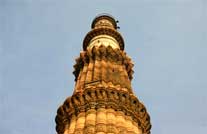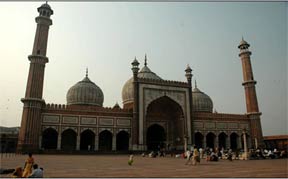|
Home >>
Destination Guide India > Delhi
DESTINATION GUIDE INDIA - DELHI
ABOUT DELHI CITY
Delhi, capital
city of the Federal Republic of India. It is one of India's
fastest growing cities. It has sprawled over the West Bank of
the river Yamuna, straddling the river. The city has two
distinct parts, Old Delhi & New Delhi. Delhi is the second
most widely used entry point into the country, being on the
route of most major airlines. It is well linked by rail, air
and road to all parts of the country. The remains of seven
distinctive capital cities - among them Shahjahanabad and
Qutub Minar - can be seen. Here, museums, art galleries and
cultural centers attract the finest exhibitions.
Delhi blends an historic past and a vibrant present. Delhi has
some of the finest museums in the country. Legend has it that
the Pandavas, the august heroes of the epic Mahabharata,
originally founded Delhi, then called Indraprastha, around
1200 B.C. Present day Delhi is built around the ruins of seven
ancient cities.
Delhi- the commercial hub has many tourist attractions to
offer. Visit vibrant shopping complex of Connaught Place,
Delhi Haat for handicraft goods and delicious food bonanza.
Pay a visit to Red Fort and Qutub Minar to view the excellence
of Mughal architecture.
TOURIST
ATTRACTIONS - DELHI CITY
»
Old Fort or Purana Quila
-- The fort is said to be
constructed on the historic site of Indraprastha (900BC) by
Humayun and Sher Shah. Covering a circuit of about a mile, the
walls of the fort have three gates and are surrounded by a
moat fed by the river Yamuna. The wall was built by Humayun
while the buildings in the fort are attributed to Sher Shar.
The notable buildings that have survived in the fort are the
Sher Mandal and the Quila-I-kholina Mosque.
» Kabuli or
Khuni Darwaza -- To the left of Chandni Chowk; there was
once a gate across the road that was called Khuni Darwaza or
the Bloody Gate. The British reoccupied Delhi on 20 September
1857 after fierce resistance by rebels. On 21 September 1857
Bahadur Shah surrendered to Hudson at Humayun's tomb. On 22
September three Mughal princes, Mirza Moghul, Mirza Khizr
Sultan and Mirza Abu Bakr were brought by Captain Hudson in a
bullock-cart and shot dead at Khuni Darwaza near Delhi Gate.
He ordered the princes to take off their upper garments and
killed them one by one. The three bodies were carried to the
Kotwali and stripped off all the clothes except a rag around
their loins, and laid on stone slabs outside the building
before they were buried. The reoccupation of Delhi was
followed by massacre and plunder and it was even suggested
that whole city be razed to the ground. Mirza Ghalib, the
great Urdu Poet, who was a witness to the killings and plunder
wrote in his Dastambu: "GOD ALONE knows the the number of
persons who were hanged. The victorious army entered the city
along the main road. Whomsoever they met on the way was
killed." The "Khuni Darwaza" still stands in its solitary
grandeur exactly opposite the main gate of the Maulana Azad
Medical College.
» Feroz Shah
Kotla -- The ruins of Ferozabad, the 5th city of Delhi,
erected by Feroz Shah Tughlaq in 1354 can be found at Feroz
Shah Kotla, just off Bahadur Shah Zafar Marg between the Old
and New Delhi. The remains of a mosque and a well can also be
seen, but most of the ruins were used for the construction of
later cities. Feroz Shah was a great builder and so, this
fifth city of Delhi was full of splendid palaces, mosques and
gardens. The Tughlaqabad area was woefully short of water and
this made the Tomars move westward to Mehrauli. Firoz Shah,
Muhammad Tughlaq's successor solved this problem by building
his new city on the banks of Yamuna. Kotla was the inner
citadel of Firozabad, built like Windsor, with great palaces
and a magnificent mosque inspiring Timur's envy. Destroyed by
the Mughals, Kotla palaces were reduced to mere ruins,
exposing to view the subterranean passages and covered
cloisters. One can still see the pyramidal structure topped by
the Ashokan Pillar brought from Topra, and a three-tiered
baoli. Timur's invasion of Delhi reduced the city to a city of
ruins as he took away with him elephants loaded with treasures
and costly building material, artists, masons and skilled
workmen as prisoners. The Saiyyads and Lodis used Kotla as
their citadel. Now more famous for the cricket ground, where
many important matches were held.
»
Tughlaqabad -- Tughlaqabad was a magnificent fort when
built by Ghiasuddin Tughlaq in 1324. But soon after his death
it became a deserted, haunted place. But the great fort & city
was never lived in and still has scarce human habitation. This
fort was built within four years between 1321 and 1324. It
contained a vast number of buildings, mosques, palaces,
towers, and tanks surrounded by mammoth bastions. In fact
Ghiyasuddin had selected this site for the fort when he was a
mere soldier. But soon it became a deserted, and a haunted
place. No enemy has attacked the fort nor has anyearthquake
destroyed it.
» Qutub
Minar -- The origins of Qutab Minar are shrouded in
controversy.
 Some
believe it was erected as a tower of victory to signify the
beginning of the Muslim rule in India. Others say it served as
a minaret to the muezzins to call the faithful to prayer. No
one can, however, dispute that the tower is not only one of
the finest monuments in India, but also in the world.
Qutab-ud-din Aibak, the first Muslim ruler of Delhi, commenced
the construction of the Qutab Minar in 1200 AD, but could only
finish the basement. His successor, Iltutmush, added three
more storeys, and in 1368, Firoz Shah Tughlak constructed the
fifth and the last storey. Some
believe it was erected as a tower of victory to signify the
beginning of the Muslim rule in India. Others say it served as
a minaret to the muezzins to call the faithful to prayer. No
one can, however, dispute that the tower is not only one of
the finest monuments in India, but also in the world.
Qutab-ud-din Aibak, the first Muslim ruler of Delhi, commenced
the construction of the Qutab Minar in 1200 AD, but could only
finish the basement. His successor, Iltutmush, added three
more storeys, and in 1368, Firoz Shah Tughlak constructed the
fifth and the last storey.
» Humayun's
Tomb -- The Mughals brought with them a love for gardens,
fountains and water. The first mature example of Mughal
architecture in India, Humayun's Tomb was built by the
emperor's grieving widow, Haji Begum, in 1565 AD. Constructed
with red sandstone and ornamented marks the beginning of a new
tradition of ornate style, which culminated in the Taj Mahal
of Agra. Designed by the Persian architect, Mirza Ghyas,
Humayun's Tomb shows a marked shift from the Persian tradition
of using coloured tiles for ornamentation. Located in the
midst of a large square garden, screened by high walls, with
gateways to the south and west, the tomb is a square tower
surmounted by a magnificent marble dome. The dome stands 140
feet from the base of the terrace and is topped with a copper
pinnacle. In addition to the remains of Humayun, the complex
also houses the grave of many other distinguished members of
the Mughal dynasty.
» Jama
Masjid -- Work on the Jama Masjid mosque was begun in 1650
by the Mughal Emperor Shah Jahan to complement his palace at
the Red Fort. More than 5,000 workers toiled for six years to
complete the largest mosque in India. Every Friday, the
emperor and his retinue would travel in state from the fort to
the mosque to attend the congressional prayers. A fine example
of Mughal architecture, the Jama Masjid has three gateways.
» Jantar
Mantar -- At first sight, the Jantar Mantar appears like a
gallery of modern art. It is, however, an observatory. Sawai
Jai Singh II of Jaipur (1699-1743), a keen astronomer and a
noble in the Mughal court, was dissatisfied by the errors of
brass and metal astronomical instruments. Under patronage from
the emperor, he set on himself the task of correcting the
existing astronomical tables and updating the almanac with
more reliable instruments. Delhi's Jantar Mantar is the first
of the five observatories that he built with large masonry
instruments. The observatory has the Samrat Yantra, a simple
equal hour sun dial, the Ram yantra for reading altitudinal
angles; Jai Prakash for ascertaining the position of the sun
and other celestial bodies, and the Misra Yantra which is a
combination of four scientific gadgets.
» Red Fort
or Lal Quila (Son-et-lumiere show) -- The mughal emperor,
Shah Jahan,
 after
ruling from Agra for elleven years, decided to shift to Delhi
and laid the foundation stone of the Red Fort in 1618. It is
called so because of the red stone with which it is built, the
Red Fort is one of the most magnificent palaces in the world.
India's history is also closely linked with this fort. It was
from here that the British deposed the last Mughal ruler,
Bahadur Shah Zafar, marking the end of the three century long
Mughal rule. It was also from its ramparts that the first
Prime Minister of India, pandit Jawharlal Nehru, announced to
the nation that India was free form colonial rule. after
ruling from Agra for elleven years, decided to shift to Delhi
and laid the foundation stone of the Red Fort in 1618. It is
called so because of the red stone with which it is built, the
Red Fort is one of the most magnificent palaces in the world.
India's history is also closely linked with this fort. It was
from here that the British deposed the last Mughal ruler,
Bahadur Shah Zafar, marking the end of the three century long
Mughal rule. It was also from its ramparts that the first
Prime Minister of India, pandit Jawharlal Nehru, announced to
the nation that India was free form colonial rule.
Daily sound and light shows are held here in Both Hindi &
English.
HOW TO REACH - DELHI
»
Air :
All the major National and International Air Lines have their
flights operating from Delhi's Indira Gandhi International
Airport.
» Rail : The Indian Railway with their modern and
organised network connects Delhi to all major and minor
destinations in India. There are three important Railway
Stations in Delhi namely New Delhi Rly. Station, Old Delhi Rly.
Station and Hazarat Nizamuddin Railway Station.
» Bus : Delhi is well connected by road to all
major destinations in North India. The Inter State Bus
Terminus (ISBT) are located at Kashmiri Gate, Sarai Kale-Khan
and Anand Vihar. Delhi Transport Corporations of the
neighbouring states provide frequent bus services through Air
Conditioned, Deluxe and Ordinary Coaches.
|
![]()